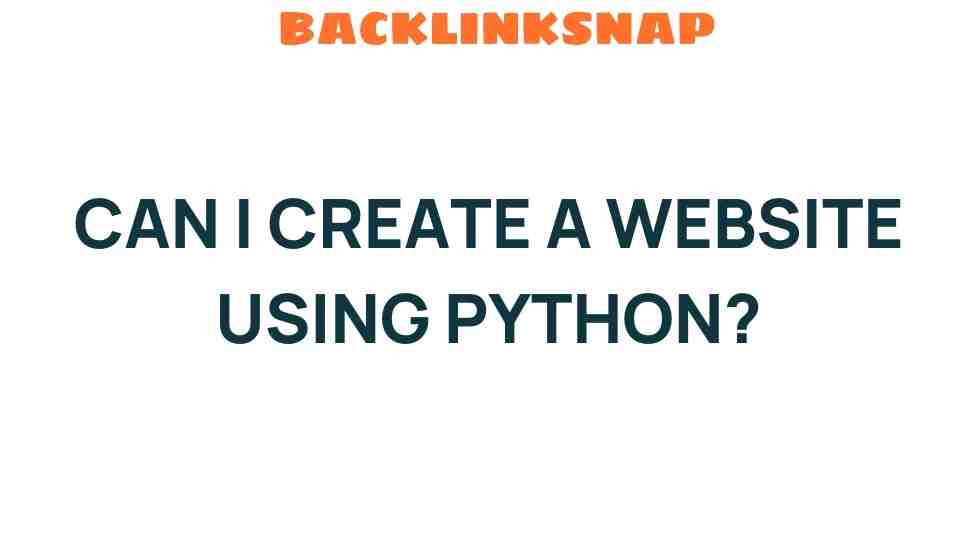Can I Create a Website Using Python? Unleashing the Power of Code
When it comes to Python web development, many budding coders ponder the question: “Can I create a website using Python?” The answer is a resounding yes! Python is not just a versatile programming language; it’s a powerful tool for building web applications and websites that can meet various needs. Whether you’re looking to create a personal blog, an e-commerce platform, or an enterprise-level application, Python offers frameworks and libraries that can help you achieve your goals.
Understanding Python Web Development
Python is widely recognized as one of the most approachable programming languages, making it an excellent choice for beginners and seasoned developers alike. The ease of learning Python is one of the reasons for its popularity in website creation. It has a clear syntax and a wealth of libraries that simplify complex tasks.
Python web development primarily involves backend development, which refers to server-side programming. This aspect of web development is crucial because it handles data management, server logic, and integration with databases. By using Python, developers can create robust, scalable applications with ease.
Popular Python Frameworks for Web Development
One of the most significant advantages of using Python for web development is the availability of frameworks that streamline the process:
- Flask: Ideal for small to medium-sized applications, Flask is a lightweight and flexible web framework. It’s easy to get started with and allows developers to build applications quickly without much overhead.
- Django: If you’re looking for a more feature-rich option, Django is the way to go. It’s a high-level web framework that encourages rapid development and clean, pragmatic design. Django comes with built-in features like authentication, database management, and an admin interface, making it suitable for larger projects.
Both Flask and Django have their own strengths, and the choice between them often depends on the project’s requirements and the developer’s familiarity with each framework.
Getting Started with Flask
Flask is an excellent starting point for newcomers to coding. To create a simple web application using Flask, you can follow these steps:
- Install Flask: Use pip, Python’s package installer, to install Flask. You can do this via the command line by typing
pip install Flask. - Create a Basic App: Create a new Python file (e.g.,
app.py) and write the following code:
from flask import Flaskapp = Flask(__name__)@app.route('/')def home(): return "Hello, World!"if __name__ == '__main__': app.run(debug=True)By running this code, you’ll have a basic web server that displays “Hello, World!” when accessed. This is just the tip of the iceberg. Flask allows for the addition of routes, templates, and much more as you grow your application.
Diving Deeper with Django
For those who wish to dive deeper into backend development, Django offers a more comprehensive environment. Here’s how to start:
- Install Django: Just like with Flask, you can install Django using pip:
pip install Django. - Create a New Project: Start a new project by running
django-admin startproject myproject. - Run the Development Server: Navigate to your project directory and run
python manage.py runserver. You’ll have a fully functional web application up and running!
Django also offers a powerful ORM (Object-Relational Mapping) system, which makes database interactions seamless and intuitive.
Why Choose Python for Web Applications?
Choosing Python for web applications comes with several benefits:
- Versatility: Python is used in various domains, from web development to data science, making it a valuable language to learn.
- Community Support: Both Flask and Django have large communities, meaning robust documentation and countless resources for troubleshooting.
- Scalability: Python frameworks can handle large applications that require scaling over time, accommodating growth without significant overhauls.
FAQs About Python Web Development
1. Can I use Python for frontend development?
While Python is primarily used for backend development, you can use tools like Brython or Transcrypt to write Python code that compiles into JavaScript for frontend development. However, traditional frontend languages like HTML, CSS, and JavaScript are more commonly used.
2. Is Flask or Django better for beginners?
Flask is often recommended for beginners due to its simplicity and flexibility. However, if you’re interested in building a comprehensive application with many built-in features, Django might be the better choice.
3. What databases can I use with Flask and Django?
Both frameworks support various databases. Flask can work with SQLite, PostgreSQL, MySQL, and more through SQLAlchemy. Django, on the other hand, comes with built-in support for SQLite, PostgreSQL, MySQL, and even Oracle.
4. Do I need to know HTML/CSS to create a website with Python?
While it’s possible to create a basic website using just Python, having knowledge of HTML and CSS is essential for creating visually appealing and well-structured web pages.
5. Is Python suitable for high-traffic websites?
Yes, with the right optimizations and infrastructure, Python can handle high-traffic websites. Frameworks like Django are designed to scale effectively.
6. Where can I learn more about Python web development?
There are many resources available online, including tutorials, courses, and documentation. Websites like Django’s official site and Flask’s documentation are great starting points.
Conclusion
In conclusion, Python is a powerful language for website creation, and with frameworks like Flask and Django, anyone can embark on a journey of building web applications. Whether you’re a novice or an experienced coder, the opportunities to create dynamic, robust websites are vast. With the right tools and a bit of creativity, you can harness the full potential of Python web development and bring your ideas to life. So, why wait? Start coding today and unlock the possibilities that await in the world of web development!
This article is in the category Digital Marketing and created by BacklinkSnap Team




